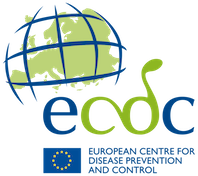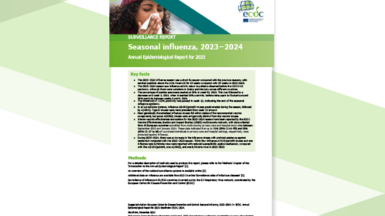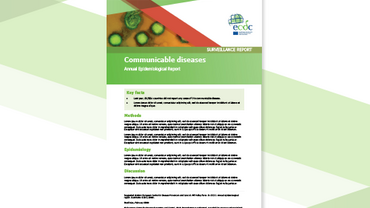Weekly influenza surveillance overview, 4 January 2013, week 52/2012
Weekly influenza surveillance in Europe for the 2012–2013 season started in week 40/2012. ECDC announced that the period of influenza transmission had started in week 49. In weeks 51 and 52, surveillance data in Europe are subject to particular delays and underreporting because of the holiday season so data should be interpreted with this in mind. In week 52, 20 of a potential 29 countries reported clinical data.• During week 52/2012, four countries (France, Italy, the Netherlands and Norway) reported medium intensity transmission; geographic spread of influenza activity was reported as widespread by five countries (Belgium, Denmark, France, Norway and the UK (England)); and nine countries reported increasing trends. • Of 375 specimens from sentinel patients, 25% were positive for influenza virus; a small decrease compared with 27% in the previous week. This may be related to a lower number of physician consultations over the New Year holiday. • Since week 40/2012, 46% of sentinel specimens were type A and 54% were type B, though the proportion of B viruses has decreased somewhat in recent weeks. Subtying of type A viruses has shown proportions of 56% A(H3) and 44% A(H1). • Viruses characterised to date match well with the vaccine viruses.• Countries undertaking surveillance of laboratory-confirmed severe influenza cases requiring hospitalisation are starting to report increasing numbers of such individuals. Influenza activity continues to rise in a number of EU/EEA countries, especially in western Europe. Greater numbers of severe laboratory-confirmed cases are now being reported.
Executive Summary
The activity of seasonal influenza continues to rise in a number of European countries, especially in western Europe. There is still time to protect yourself from getting or spreading the flu by being vaccinated.
Influenza season on the rise
Four countries (France, Italy, the Netherlands and Norway) have reported medium intensity influenza transmission; geographic spread of influenza activity was reported as widespread by five countries (Belgium, Denmark, France, Norway and the UK (England)); and nine countries have reported increasing trends. The proportion of sentinel specimens that are positive for influenza has exceeded 20% for two consecutive weeks. Countries undertaking surveillance of laboratory-confirmed severe influenza cases are starting to report increasing numbers of such individuals having to be hospitalised.
So far the detected viruses remain well-matched to the vaccine strain and there has been no change in the viruses from what was seen last season. Since week 40/2012, 46% of sentinel specimens were type A and 54% were type B, though the proportion of B viruses has decreased somewhat in recent weeks. Subtying of type A viruses has shown proportions of 56% A(H3) and 44% A(H1).
Influenza should be taken seriously
Influenza comes to Europe every winter – each year, around 10% of us are infected, and influenza-related complications cause hundreds of thousands of hospitalisations all across Europe. We can reduce the risk of getting influenza or transmitting it to others by a number of preventive measures, from applying better hand hygiene and not sneezing on others to staying at home when sick. Older people as well as those with chronic conditions suffer the most, but even perfectly healthy young people are at risk of developing serious complications, which can be fatal. Influenza-related deaths seen in recent weeks, for example, in Norway and Poland, have been reported in the media; sadly, they highlight what is unfortunately to be expected. Therefore people whose symptoms of the flu are worsening should seek medical advice as recommended by their national or local authorities.
Still time to get protected
The single most effective way to protect yourself as well as those around you is by getting vaccinated. Influenza transmission has significantly progressed since Week 48 when ECDC Director Marc Sprenger encouraged all Europeans who are recommended to have the influenza vaccine by their national authorities to get vaccinated. It is still not too late to do so now. Influenza vaccination is of particular importance for those in the recognised risk groups and for healthcare workers, as it protects their vulnerable patients as well as themselves.
Throughout the influenza season, ECDC continues to monitor the situation and provide weekly surveillance overview and maps on seasonal influenza activity in Europe.
Resources:






